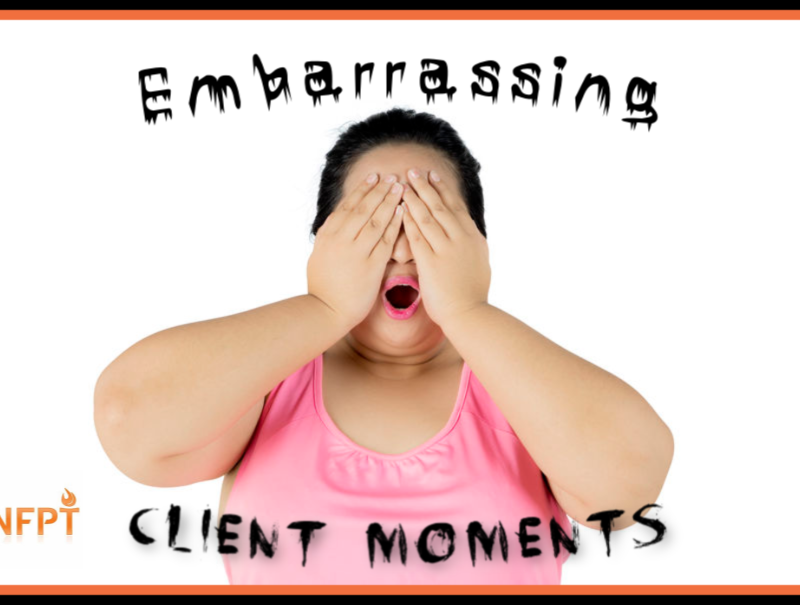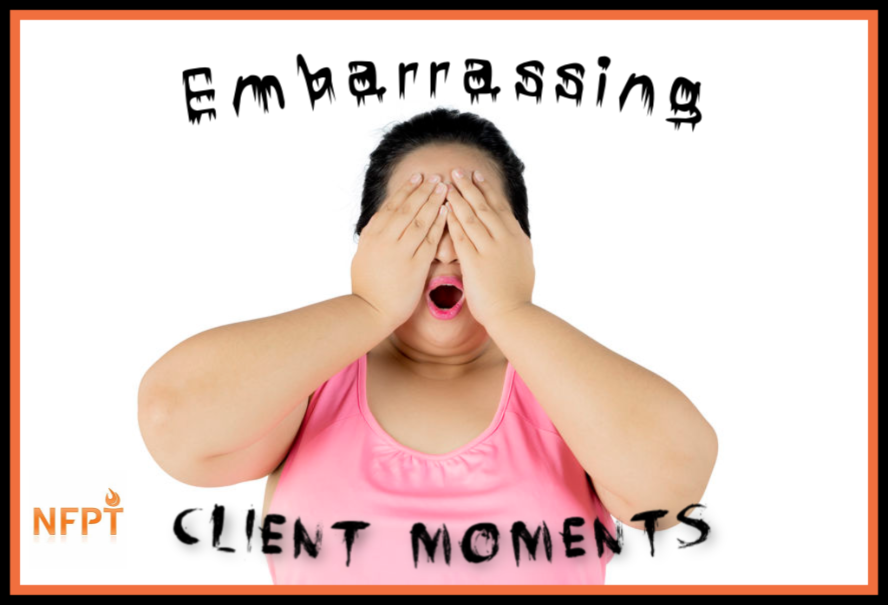
We’ve all been there–your client does something he or she finds embarrassing and you must handle the moment with grace and aplomb. If you are caught off guard in such situations you could make the interaction even more uncomfortable, or potentially even lose your client, by reacting without thinking or failing to react at all. Remaining professional yet compassionate might spare your client from feeling mortified.

Here are some common uncomfortable scenarios you are bound to encounter at some point in your fitness career:
Profuse Perspiration
Certainly the most common issue and one we have to expect as personal trainers: some people are simply genetically programmed to sweat a lot. Personally, this doesn’t bother me, and if it bothers you, you may want to rethink your career choice because we’re in the sweat-generation business!
But something you may not be prepared for is the degree to which some clients are deeply embarrassed by their perspiration predilection. I’ve had at least two clients over the years who would sweat heavily within the first 10 minutes and then become fixated on their condition.
It might take a while to develop a deep enough trust connection for your client to confide that they are embarrassed by their sweating. It might be helpful for you to become tuned in to someone’s personal “discomfort” cues, such as constant towel-dabbing and shirt-pulling, and certain facial expressions pointing to their frustration.
There are steps you can take in this scenario to assuage the discomfort, and even do so discreetly.
If it’s within your control, jack up the A/C before your client arrives. If not, park your client in front of a fan for the entirety of their workout. Have clean towels (plural) nearby for him or her to grab if needed. You could even provide a handheld squirt bottle with a built-in fan, or frozen washcloths to help bring down the heat a notch.
You might also consider a slower workout that doesn’t elevate the heart rate as much but can still be challenging. This will, of course, depend on the client’s goals, but it may be a good idea to front-load the session with slow heavy lifting and finish with cardio if that’s what they are intent on.
You could take the solidarity approach if you also have a propensity to perspire. Workout with him or her and demonstrate your comfort with your own sweat.
If your client makes comments about their level of perspiration or how drenched their clothing is, you should immediately reassure him or her that you couldn’t care less and it’s only a sign of hard work! You might also mention the genetic predisposition and that you wouldn’t be in this business if you didn’t expect to encounter other people’s sweat.
With any luck, this is the worst you’ll ever have to deal with, but more likely than not, one of the following more sensitive situations are also bound to arise.
Body Odor
Most of us have the ability to recognize when our ‘pits are bit “ripe” mid-workout. For whatever reason, some folks just don’t smell themselves or might not be able to do anything about their body odor despite best efforts. Intense body odor might accompany profuse sweating as mentioned above, but some people might have some genuine hygiene issues and are just emanating a reek that you can’t handle.
This one is Tricky (with a capital T).
Depending on your level of tolerance, this might be one best left alone if it’s at-all bearable. However, you might have this client in a big gym where it’s clear others’ sensibilities are offended and people make a show of it. While we don’t want to offend our well-paying, hard-working client, we also don’t want to deter other patrons. And truly, if you can’t handle the odor while you’re training, how well are you concentrating?
If this is a newish client in a member-based gym and the stench is bowl-you-over-bad, then your best bet is to have the gym or fitness manager pull the client aside to tactfully explain the club’s policies, i.e., do NOT take matters into your own hands on this one. You’ll probably lose the client.
If the odor is simply a tad odious, then it may be for the best to just let it go and not risk embarrassing the client for little gain. Don’t forget, some folks adhere to normal hygiene and simply can’t attenuate the effluvium. Really weigh how offensive the situation is before taking action.
If the client has been with you a long time and you have developed a great bond and relationship, well….if it has withstood the test of time, probably the smell wasn’t all that bad! But, if it was offensive enough to make you dread your encounters, you might be able to playfully hint at the noxious nature of the client’s output without directly addressing it. Like, make a joke about a smell without pointing the finger and see if they “catch on”.
Think of it this way…you naturally don’t want to outright offend someone by pointing out an inherent flaw, but you might also be doing this person a long-term favor by saving future embarrassment by others who may be judging or making fun of the client with or without their knowledge.
So if it’s possible to break the news or allude to the problem tactfully and compassionately, it might be the kindest thing you ever do for them! Again, you must feel comfortable enough with this person to do so, and this is a rare situation!
Bad Breath
Well, this isn’t far off from the above, but certainly more easily managed or overlooked. Keep your physical distance as best you can, have gum or breath mints on hand and just. Always. Offer. One….
You, of course, should also take one so as to not be too obvious with your intentions. With luck, your client will accept the mint and takes the hint.
Breaking Wind
Yep. Program in enough crunches or schedule enough post-lunch workouts, and plan on at least one client a year letting one slip. This one is sensitive because it will be highly dependent on the client’s attitude towards breaking wind. I’ve had clients totally just crack up and I would just laugh with them. This is by far the best case scenario.
The second least uncomfortable possibility is that the client pretends they didn’t know they did that and YOU ALSO PRETEND THAT. Trust me, if they don’t acknowledge it, you best play dumb as a doornail to avoid humiliating your client even more!
The last likelihood is that the client just gets instantly embarrassed—can’t laugh, can’t make eye contact, can’t speak, expect maybe to say, “Oh my Goodness, how embarrassing…” To which you will say, “Oh my GOSH! Totally NOT! Happens all the time! Means you were properly engaging your pelvic floor! WAY TO GO!” And high five the heck out of ’em.
Yes, make them laugh and forget their momentary loss of control. We’re training human beings, not machines.
Hurling
My first client and also one of my longest-running clients whom I would still have today if I hadn’t moved away from where he lives, claimed to be a regular exerciser, at age 50, when we first started. I came to his home and we worked out in a small home gym.
Well, the first month I was getting to know him and pushed him only moderately hard in my estimation. I wish I could remember this particular workout but I am confident in declaring it was pretty unremarkable on the intensity scale. However, mid-way through, my client became nauseous and had to sit down on the floor. I told him to drink water, but he did not look well. He started dry heaving, leaving me frantic and unsure of what to do.
His son was home and he told me to get him, so I did. His son mercifully told me I should probably go. I felt like a failure and that I must have pushed him too hard. But what my client felt was embarrassed. We talked about it later and realized he hadn’t eaten breakfast that morning and it simply did not work for him. From then on out he ate an hour before and never again had an issue.
If you find yourself faced with a nauseous client, sit them down and slow their breathing. Only offer water if they feel thirsty or want it. More water sloshing around might make matters worse. And in fact, having too much water in the system could be the cause of the nausea in the first place.
In addition to not eating at all, eating too soon before a workout can also cause a problem. Make sure your client doesn’t eat a meal sooner than 90 minutes before exercising.
You already should know that pushing your clients hard enough to puke is not the mark of a good trainer but of an irresponsible one. But, do be aware that other factors can influence a client’s constitution. If it happens once, explore the details of the day to see if you can’t pinpoint a culprit. If it happens often, and no explanation can be found, definitely refer the client to their medical professional.
Exercise “Fail”
That same client I mentioned above suffered another embarrassing moment when a resistance band broke and he went flying backward. My first inclination was to feel responsible and that I let him down as a trainer by allowing him to fall. (There is truth to that, no doubt, but not the point.) His instinct, however, was to feel silly for falling.
Remember this: Your client is unlikely to blame you for her own perceived clumsiness or equipment failure….she’ll just feel embarrassed.
The best insurance you have to prevent that type of exercise fail is not to utilize exercise bands like suspension trainers. In other words, don’t allow your client to put the full expression of their body weight into the band resistance.
That being said, there are still moments like rolling off a stability ball, almost (or actually) dropping a free weight, losing balance while on one foot (or BOSU or balance board), or even simply tripping over equipment that can either hurt your client or just embarrass the heck out of him or her.
First, ensure the client is not injured and if so, deal with that first and foremost. If there is nothing more than a bruised ego, then reassure your client that we’ve all been there. Maybe share an embarrassing story of your own, and if you don’t have one, divert attention away from the mishap and toward the next exercise.
Compassion and Grace Rule the Space
No matter what the scenario that causes your client chagrin, just don’t be a jerk about it. I shouldn’t have to mention that, but I know there are some people out there whose first instinct is to laugh or magnify an already off-putting situation because they lack empathy.
No one likes to look “stupid”, for lack of a better word, so don’t go out of your way to make someone feel worse if they suffer a face-reddening moment. Put yourself in their shoes and try to react in a way that might make you feel less vulnerable if roles were reversed.
Then put the situation behind you both and make sure your client feels that you are there to be her coach and support system above all else.
What other scenarios have you encountered with a client that were super awkward, but you expertly and professionally handled as a trainer?






